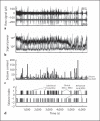A novel approach to the study of hypoxia-ischemia-induced clinical and subclinical seizures in the neonatal rat
- PMID: 21952605
- PMCID: PMC7065396
- DOI: 10.1159/000331646
A novel approach to the study of hypoxia-ischemia-induced clinical and subclinical seizures in the neonatal rat
Abstract
Perinatal hypoxic-ischemic encephalopathy (HIE) is a major cause of acute mortality and chronic neurologic morbidity in infants and children. HIE is the most common cause of neonatal seizures, and seizure activity in neonates can be clinical, with both EEG and behavioral symptoms, subclinical with only EEG activity, or just behavioral. The accurate detection of these different seizure manifestations and the extent to which they differ in their effects on the neonatal brain continues to be a concern in neonatal medicine. Most experimental studies of the interaction between hypoxia-ischemia (HI) and seizures have utilized a chemical induction of seizures, which may be less clinically relevant. Here, we expanded our model of unilateral cerebral HI in the immature rat to include video EEG and electromyographic recording before, during and after HI in term-equivalent postnatal-day-12 rats. We observed that immature rats display both clinical and subclinical seizures during the period of HI, and that the total number of seizures and time to first seizure correlate with the extent of tissue damage. We also tested the feasibility of developing an automated seizure detection algorithm for the unbiased detection and characterization of the different types of seizure activity observed in this model.
Copyright © 2011 S. Karger AG, Basel.
Figures





References
-
- Vannucci RC. Hypoxic-ischemic encephalopathy. Am J Perinatol. 2000;17:113–120. - PubMed
-
- Volpe JJ. Perinatal brain injury: from pathogenesis to neuroprotection. Ment Retard Dev Disabil Res Rev. 2001;7:56–64. - PubMed
-
- Cowan LD. The epidemiology of the epilepsies in children. Ment Retard Dev Disabil Res Rev. 2002;8:171–181. - PubMed
-
- Eicher DJ, Wagner CL, Katikaneni LP, Hulsey TC, Bass WT, Kaufman DA, Horgan MJ, Languani S., Bhatia JJ, Givelichian LM, Sankaran K., Yager JY. Moderate hypothermia in neonatal encephalopathy: safety outcomes. Pediatr Neurol. 2005;32:18–24. - PubMed
-
- Gluckman PD, Wyatt JS, Azzopardi D., Ballard R., Edwards AD, Ferriero DM, Polin RA, Robertson CM, Thoresen M., Whitelaw A., Gunn AJ. Selective head cooling with mild systemic hypothermia after neonatal encephalopathy: multicentre randomised trial. Lancet. 2005;365:663–670. - PubMed
MeSH terms
Grants and funding
LinkOut - more resources
Full Text Sources
Medical

